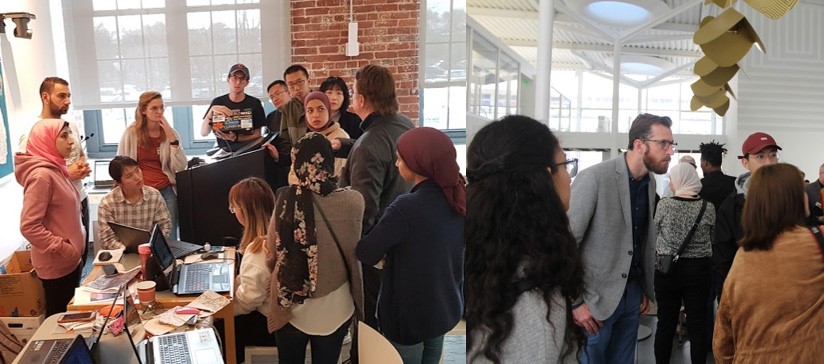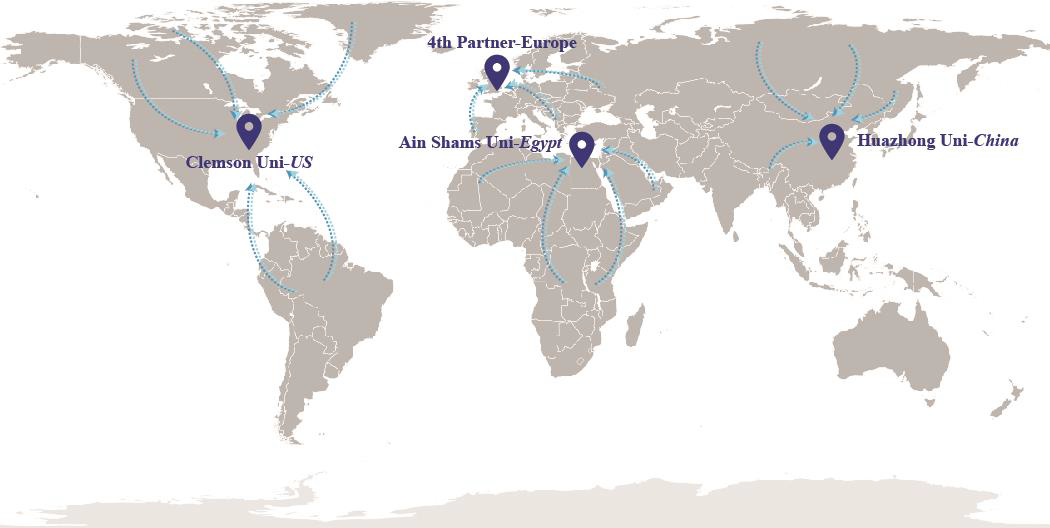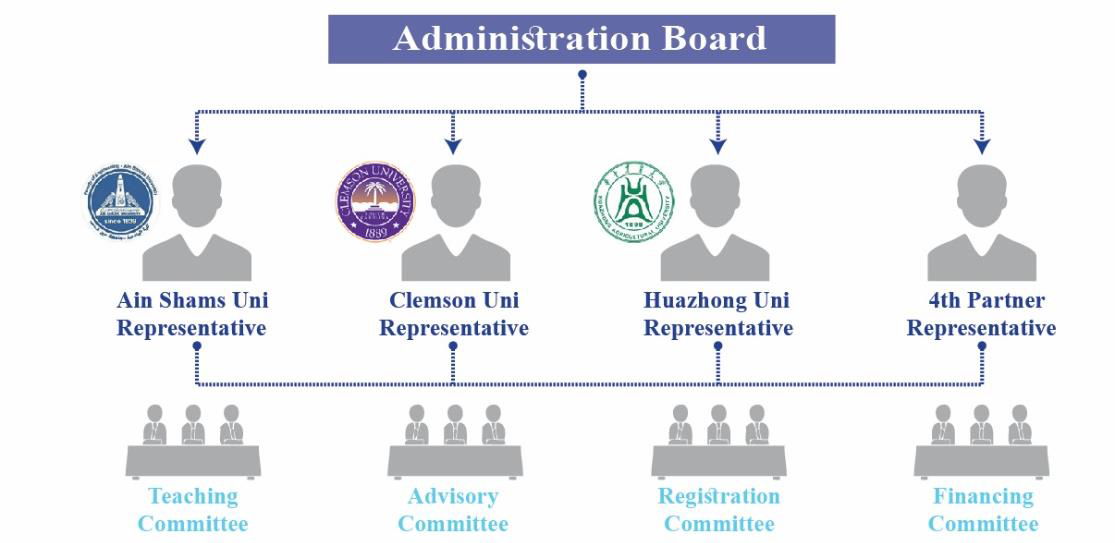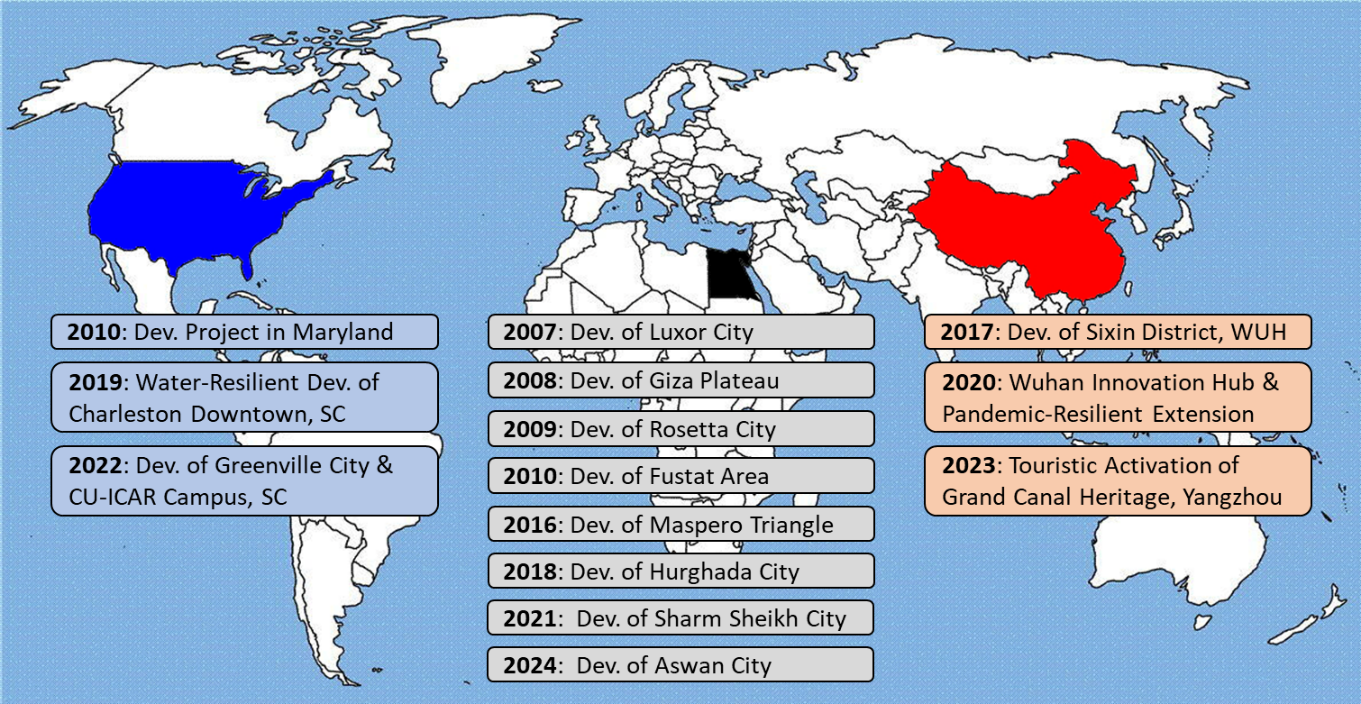Graduation Projects
WDS
WDS in Brief
The World Design Studio (WDS) is an outstanding collaboration between the Department of Architectural Engineering, Faculty of Engineering in Ain Shams University (ASU) in Egypt, Program of Landscape Architecture, School of Architecture in Clemson University in the United States, Department of Landscape Architecture in Huazhong Agricultural University (HZAU) in China and prospectively a fourth partner from Europe. The multi-disciplinary and cross-cultural design studio employs the knowledge, expertise and diverse facilities of the partner Universities in developing the skills of students.


WDS Vision
WDS vision is to establish a platform open for students worldwide to engage in a multi-disciplinary learning experience that qualifies them to be competitors in the global market of jobs. WDS will celebrate the diversity of its partners and direct it to create strong cross-cultural communication among them on multiple levels (Administration, faculty members, students and alumni) and to graduate students who can face local, national and global challenges.
WDS Mission
WDS mission is to allow for: knowledge exchange between the partner Universities, their professors and staff members, research faculty, and students whether undergraduate or postgraduate through multidisciplinary international collaborative funded projects, research, consultation, and community engagement. On the institutional level of the Universities, it will allow for cross-cultural enrichment of curriculum, teaching pedagogy and learning outcomes through the development of WDS that will fit the requirements of four Universities from four educational systems.
WDS Objectives and Offerings
The studio hosts students from the four continents; Africa, North America, Asia and Europe. It is the first studio of its kind, employing the knowledge and expertise of partner Universities in developing the skills of the students in the field of Architectural Design and Landscape Architecture through engaging in joint projects that targets studying and proposing solutions to real-world problems world-wide. The WDS is intended to grow to incorporate a wider range of disciplines, including: a range of engineering specializations, the biological, natural sciences and agriculture, the arts and humanities. It is intended to offer project-based coursework broadly focused on contemporary community engagement, economic development, innovation, sustainability, resilience, advanced manufacturing and materials, analytics, energy and transportation, potentially anywhere in the world. The WDS will accept applicants who are undergraduate students or post graduate students working on their Master or PhD degrees.
WDS Objectives and offerings can be divided as follows:
-
Educational Objective:
Enhancing the quality of education in the fields of Architecture, Landscape Architecture and other disciplines (urban, engineering, natural sciences, arts and humanities) through engagement with outstanding international university partners of outstanding expertise and facilities.
- The WDS has been offering annual interdisciplinary studios since 2006 that began with Clemson University and Ain Shams University and now includes Huazhong University, and prospectively a fourth European partner.
- The WDS offers on-site workshops introduced by Clemson, Huazhong and Ain Shams Universities that can now include a fourth European partner.
- The WDS studios’ requirements are tailored to fit the undergraduate and post graduate students.
-
Academic Exchange Objective:
Exchanging knowledge, skills and experiences among professors and students from partner universities to enrich university programs in a global context.
- WDS has developed student exchange programs, which can be expanded between the partner universities.
- WDS partners are engaged in joint supervision of Master’s and PhD students.
- WDS partners are developing research collaborations to secure funding grants from continental/national grant systems (ex. Newton Moshrafa, DAAD, EU, USAID, UNESCO, International and national Chinese sources, Pan-African, STDF).
- WDS partners have developed global programs with academic and private partners for new entrepreneurial/technological innovation associated with enterprise, industry and research, open to a wide variety of disciplines with open global enrolment.
-
Cultural Exchange Objective:
Strengthening the cultural relations and exchange between African, American, Asian and European students through pedagogy, interactive cross-cultural learning setting and outreach within international settings.
- WDS partners encourage open global student enrolment through each representative University.
- WDS partners have developed shared undergraduate degrees, and contemplate shared and global certificates.
- The learning environment and chosen teaching strategies focus on the interaction and engagement of students from the diverse background together in projects for teaching them the successful intercultural communications and how to overcome their differences.
-
Developmental and Communal Objectives:
Benefiting from the international expertise in providing well-grounded solutions for the most urgent problems in the partnering countries and applying lessons learned from the best practices world-wide.
Serving the wider community with focus on sustainable development since the chosen projects always focus on real-world challenges that need intervention from the academic community through research and design proposals.
WDS Managerial Plan and Structure
WDS partner Universities are chosen to be located all over the world so that each region is represented by a University that acts as the main attraction point for students from its neighboring countries to reach the utmost coverage over the four continents as shown in the figure. Interested students from each region will apply to the nearest partner university to be part of the WDS.

The managerial structure of the WDS partners will be as per the following: Each University will nominate a representative to be a member in the higher administration board and is considered as the program coordinator in the University. Each year these representatives decide on the plan for the year and define the details of the studied project together with strong consultation from the side of the host University coordinator.
The representatives will also manage a number of committees including the committee for teaching, the committee for advisory, the committee for application and registration and the committee for financing having representatives from each partner University.

WDS inside ASU
The “World Design Studio (WDS)” is delivered to international students through the collaboration of the partner Universities. Its academic system will abide by the international codes and standards to fulfil the requirements of the different Universities. On the side of ASU, the interdisciplinary WDS studio will follow the credit hour system and will host students from four programs running in the faculty:
- Architecture Engineering Program (ARCH).
- Environmental Architecture and Urbanism Program (ENVR).
- Landscape Architecture Program (LAAR).
- Housing Architecture and Urban Development Program (HAUD).
Accordingly, the WDS as a studio will have to be included under the umbrella and management of the International Credit Hours Programs (ICHEP) System of the faculty since it fits perfectly under the internationalization direction of the programs. The figure below shows WDS administrative structure.

WDS Academic Structure
WDS targeted group includes 4th year Senior students in each of the previously mentioned four programs (ARCH, ENVR, LAAR, HAUD). The first semester in each program is a preparatory course for the WDS Graduation Project Course coded according to the respective program bylaws.
Appendix A
WDS Program History and Background
Since 2006, Clemson University Landscape Architecture faculty and students have been working with Ain Shams University Architectural Engineering faculty and students in parallel collaborative cross-cultural design studios focusing on community engagement and design for some of the most important heritage sites in the world. This academic partnership, celebrated by an MOU between the two universities, has yielded multiple international, regional and state collaborative community engagement projects. The design studios have achieved the highest level of recognition, review and awards and have been recognized in national and international forums during the last decade, including the Aga Khan Program at MIT, National Geographic Society, Cornerstone Sonoma, and by the Governor of Luxor, the Prime Minister of Egypt, the American Society of Landscape Architects (Tri-State Award), the American Society of Landscape Architects - South Carolina, the Council of Educators in Landscape Architecture (CELA) national & international awards, and Ain Shams University Awards of Excellence.
Each year, the project is sponsored by different entities where two workshops are organized each year in the hosting countries. In these workshops, the students go on site visits to the studied area, start forming groups to work together on the status-quo analysis and on the proposals’ development. The workshops usually host a large number of academic professors, governmental representatives as well as external experts in the field. Through the bilateral cooperation between Ain Shams University and Clemson University from 2007 to 2016, design solutions were provided for national projects that began with the development of the city of Luxor, the development of the Pyramids Plateau in Giza, the development of Rosetta City, and the development of the Fustat area and the Maspero Triangle in Cairo.
Then, the memorandum of understanding for tripartite cooperation was signed by joining the Chinese University under the name World Design Studio in 2019 in the presence of Professor Dr. Muhammad Ayman Ashour, Dean of the Faculty of Engineering at that time. The World Design Studio projects began after the Chinese University joined the development of the Sixin district in China in 2017, with the travel of an Egyptian team consisting of 10 students and 2 faculty members.
Then, in 2018, there was a project to develop the old port area and the tourist promenade in Hurghada, Egypt, and a team from the two universities participating in the World Design Studio, with about 20 students and 4 faculty members, sponsored by the Governor of the Red Sea. In 2019, the project was to develop the city of Charleston in the United States of America, and about 20 Egyptian students, 4 faculty members, and the Dean of the Faculty of Engineering travelled to attend the signing ceremony of the tripartite cooperation agreement to establish the World Design Studio.
After that, during the years 2020, 2021 and 2022, there was the emergence of the Covid-19 pandemic, which led to the cessation of travel between university teams participating in World Design Studio projects, and communication was limited to online meetings and virtual exchange. Projects during that period included developing the extension of the city of Wuhan in China in 2020, developing the city of Sharm El-Sheikh as an international tourist city in 2021, developing the city of Greenville in the United States of America, and designing the new campus of Clemson University in Greenville in 2022.
With the continuation of the travel restrictions in China in 2023, the Egyptian team travelled to the United States of America with about 20 students and 5 faculty members to participate with the American team in direct collective work in the development, heritage revival, and tourism revitalization of the Yangzhou city area in China, and the Chinese team participated through Virtual communication then.
In the current year 2024, the targeted project was to develop the city of Aswan as the capital of African culture, economy and youth. The Chinese team travelled to participate with the Egyptian team in field visits and studies on projects in the city of Aswan, with about 20 Chinese students and 2 faculty members, sponsored by the Governor of Aswan and supported by the Ministry of Higher Education and Scientific Research.

Contact us
